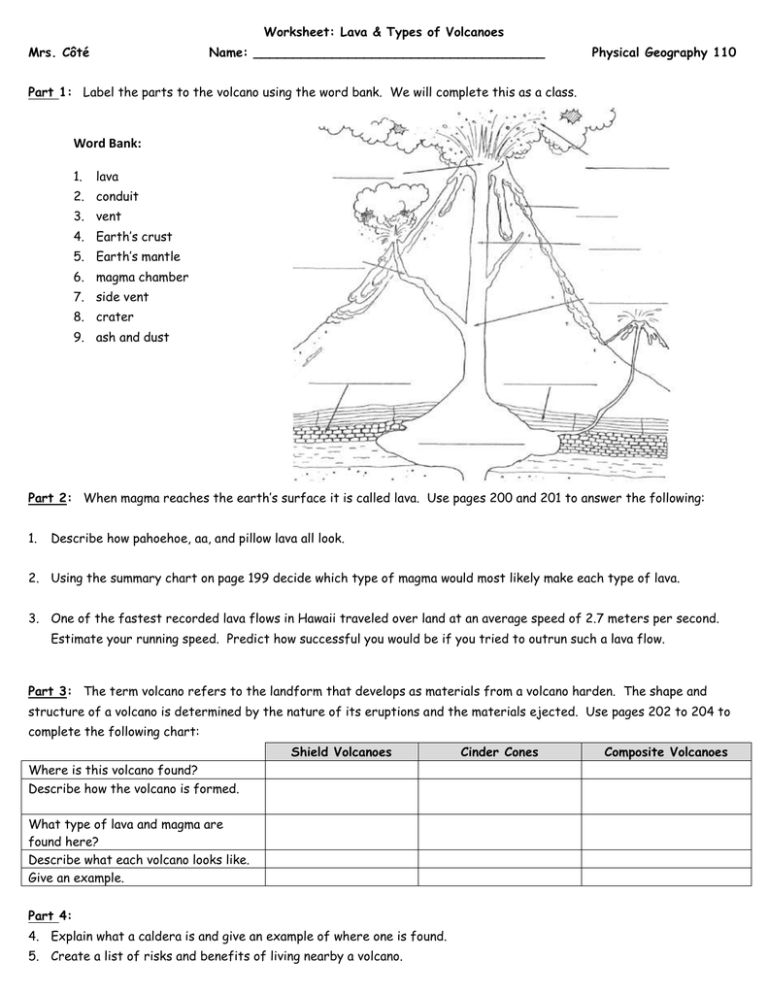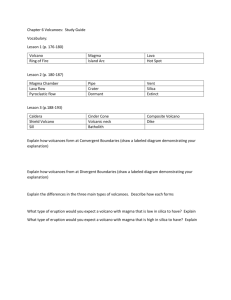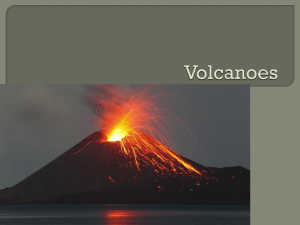Lava & Volcano Types Worksheet - Physical Geography
advertisement

Worksheet: Lava & Types of Volcanoes Mrs. Côté Name: _____________________________________ Physical Geography 110 Part 1: Label the parts to the volcano using the word bank. We will complete this as a class. Word Bank: 1. lava 2. conduit 3. vent 4. Earth’s crust 5. Earth’s mantle 6. magma chamber 7. side vent 8. crater 9. ash and dust Part 2: When magma reaches the earth’s surface it is called lava. Use pages 200 and 201 to answer the following: 1. Describe how pahoehoe, aa, and pillow lava all look. 2. Using the summary chart on page 199 decide which type of magma would most likely make each type of lava. 3. One of the fastest recorded lava flows in Hawaii traveled over land at an average speed of 2.7 meters per second. Estimate your running speed. Predict how successful you would be if you tried to outrun such a lava flow. Part 3: The term volcano refers to the landform that develops as materials from a volcano harden. The shape and structure of a volcano is determined by the nature of its eruptions and the materials ejected. Use pages 202 to 204 to complete the following chart: Shield Volcanoes Where is this volcano found? Describe how the volcano is formed. What type of lava and magma are found here? Describe what each volcano looks like. Give an example. Part 4: 4. Explain what a caldera is and give an example of where one is found. 5. Create a list of risks and benefits of living nearby a volcano. Cinder Cones Composite Volcanoes Worksheet: Lava & Types of Volcanoes Mrs. Côté Name: _____________________________________ Physical Geography 110 Part 1: Label the parts to the volcano using the word bank. We will complete this as a class. Word Bank: 1. lava 2. conduit 3. vent 4. Earth’s crust 5. Earth’s mantle 6. magma chamber 7. side vent 8. crater 9. ash and dust Part 2: When magma reaches the earth’s surface it is called lava. Use pages 200 and 201 to answer the following: 1. Describe how pahoehoe, aa, and pillow lava all look. 2. Using the summary chart on page 199 decide which type of magma would most likely make each type of lava. 3. One of the fastest recorded lava flows in Hawaii traveled over land at an average speed of 2.7 meters per second. Estimate your running speed. Predict how successful you would be if you tried to outrun such a lava flow. Part 3: The term volcano refers to the landform that develops as materials from a volcano harden. The shape and structure of a volcano is determined by the nature of its eruptions and the materials ejected. Use pages 202 to 204 to complete the following chart: Shield Volcanoes Where is this volcano found? Describe how the volcano is formed. What type of lava and magma are found here? Describe what each volcano looks like. Give an example. Part 4: 4. Explain what a caldera is and give an example of where one is found. 5. Create a list of risks and benefits of living nearby a volcano. Cinder Cones Composite Volcanoes






